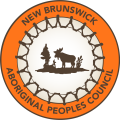Local Wolastoq artist Susan Sacobie created a piece of art to represent the Looking Out For Each Other project. She says:“This painting is for the missing and murdered Wolastoqiyik & Mi’kmak women that were almost forgotten. The five women in this piece represent knowledge, faith, wisdom, justice and peace. They are wearing our traditional peaked hats decorated with the double curve motifs. The wampum belt on the bottom is our promise to each woman that their lives will be remembered, celebrated, honoured. The wampum belt is also a promise to each Native woman that we have to rebuild our matriarchal standing within each of our families & communities. We must humble ourselves and learn and teach one another about who we are, where we come from and to not be silent and share our individual stories so we can empower our sisters, stay connected and strong and in turn we keep our families and communities strong. Their connecting shields are protecting us and reminding each of us that it is an obligation and a privilege to guard one another because we are all connected. As mothers and daughters, the living as well as the women who crossed the rainbow bridge we have to tell ourselves and each other our lives matter, we are important and we have to love and respect each other unconditionally and stand together.” These words and the voices of Indigenous women will continue to guide the project.
Curriculum
Class: Reporting on missing Indigenous People
This is designed as a module to fit in a course on reporting in a post-secondary journalism program in Canada. It includes a summary, learning outcomes, recommended readings, in-class exercise and assignment.
This module is designed as a two-hour class for journalism students in their second year or higher because it presumes students have some understanding of the basics of reporting. It could be adapted to suit the needs of the instructor or journalism program. For example, it could be incorporated into a general reporting course or one specific to reporting in and for Indigenous communities, stretched to cover multiple classes, or offered as a separate seminar.
It is strongly advised to include other Indigenous cultural competency education elements in any reporting course, including specific information on the territory or territories in which you reside. This is important for you as an instructor too. Teaching your students means preparing yourself for the task. Read the materials and consider holding another educational component ahead of time. It’s recommended to have some training on trauma-informed reporting. Bring in a guest speaker, such as a journalist who has experience reporting in and for Indigenous communities.
How do you report responsibly on a missing Indigenous person? How do you weigh the importance of accuracy, fairness and independence — the core principles of journalistic ethics and standards in Canada — with the need for empathy and cultural competency? By using specifically designed media guidelines and case studies, this class examines the particular challenges journalists face when covering these stories and identifies ways to tell them that are more accurate and human-centred.
Videos

Michelle Perley
LOFEO Project Manager

Nic Meloney
Wolastoqi/Canadian Production Executive, CBC Unscripted

Trina Roache
Assistant Professor/Rogers Chair in Journalism, University of King’s College





